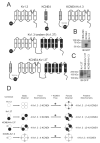Functional Consequences of the Variable Stoichiometry of the Kv1.3-KCNE4 Complex
- PMID: 32370164
- PMCID: PMC7290415
- DOI: 10.3390/cells9051128
Functional Consequences of the Variable Stoichiometry of the Kv1.3-KCNE4 Complex
Abstract
The voltage-gated potassium channel Kv1.3 plays a crucial role during the immune response. The channel forms oligomeric complexes by associating with several modulatory subunits. KCNE4, one of the five members of the KCNE family, binds to Kv1.3, altering channel activity and membrane expression. The association of KCNEs with Kv channels is the subject of numerous studies, and the stoichiometry of such associations has led to an ongoing debate. The number of KCNE4 subunits that can interact and modulate Kv1.3 is unknown. KCNE4 transfers important elements to the Kv1.3 channelosome that negatively regulate channel function, thereby fine-tuning leukocyte physiology. The aim of this study was to determine the stoichiometry of the functional Kv1.3-KCNE4 complex. We demonstrate that as many as four KCNE4 subunits can bind to the same Kv1.3 channel, indicating a variable Kv1.3-KCNE4 stoichiometry. While increasing the number of KCNE4 subunits steadily slowed the activation of the channel and decreased the abundance of Kv1.3 at the cell surface, the presence of a single KCNE4 peptide was sufficient for the cooperative enhancement of the inactivating function of the channel. This variable architecture, which depends on KCNE4 availability, differentially affects Kv1.3 function. Therefore, our data indicate that the physiological remodeling of KCNE4 triggers functional consequences for Kv1.3, thus affecting cell physiology.
Keywords: immune system; oligomeric complex; potassium channels; regulatory subunits.
Conflict of interest statement
The authors declare no conflicts of interest with the contents of this article.
Figures







Similar articles
-
The calmodulin-binding tetraleucine motif of KCNE4 is responsible for association with Kv1.3.FASEB J. 2019 Jul;33(7):8263-8279. doi: 10.1096/fj.201801164RR. Epub 2019 Apr 10. FASEB J. 2019. PMID: 30969795
-
KCNE4 suppresses Kv1.3 currents by modulating trafficking, surface expression and channel gating.J Cell Sci. 2009 Oct 15;122(Pt 20):3738-48. doi: 10.1242/jcs.056689. Epub 2009 Sep 22. J Cell Sci. 2009. PMID: 19773357
-
KCNE4-dependent modulation of Kv1.3 pharmacology.Biochem Pharmacol. 2024 Aug;226:116368. doi: 10.1016/j.bcp.2024.116368. Epub 2024 Jun 14. Biochem Pharmacol. 2024. PMID: 38880360
-
KCNE4 and KCNE5: K(+) channel regulation and cardiac arrhythmogenesis.Gene. 2016 Nov 30;593(2):249-60. doi: 10.1016/j.gene.2016.07.069. Epub 2016 Jul 30. Gene. 2016. PMID: 27484720 Free PMC article. Review.
-
The Phosphorylation of Kv1.3: A Modulatory Mechanism for a Multifunctional Ion Channel.Cancers (Basel). 2023 May 11;15(10):2716. doi: 10.3390/cancers15102716. Cancers (Basel). 2023. PMID: 37345053 Free PMC article. Review.
Cited by
-
Calmodulin-dependent KCNE4 dimerization controls membrane targeting.Sci Rep. 2021 Jul 7;11(1):14046. doi: 10.1038/s41598-021-93562-5. Sci Rep. 2021. PMID: 34234241 Free PMC article.
-
Kv2 channel-AMIGO β-subunit assembly modulates both channel function and cell adhesion molecule surface trafficking.J Cell Sci. 2021 Jun 15;134(12):jcs256339. doi: 10.1242/jcs.256339. Epub 2021 Jun 17. J Cell Sci. 2021. PMID: 34137443 Free PMC article.
-
KCNE4-dependent functional consequences of Kv1.3-related leukocyte physiology.Sci Rep. 2021 Jul 16;11(1):14632. doi: 10.1038/s41598-021-94015-9. Sci Rep. 2021. PMID: 34272451 Free PMC article.
-
Fluorescence Fluctuation Spectroscopy enables quantification of potassium channel subunit dynamics and stoichiometry.Sci Rep. 2021 May 21;11(1):10719. doi: 10.1038/s41598-021-90002-2. Sci Rep. 2021. PMID: 34021177 Free PMC article.
References
-
- Vicente R., Escalada A., Villalonga N., Texido L., Roura-Ferrer M., Martin-Satue M., Lopez-Iglesias C., Soler C., Solsona C., Tamkun M.M., et al. Association of Kv1.5 and Kv1.3 contributes to the major voltage-dependent K+ channel in macrophages. J. Biol. Chem. 2006;281:37675–37685. doi: 10.1074/jbc.M605617200. - DOI - PubMed
Publication types
MeSH terms
Substances
LinkOut - more resources
Full Text Sources
Molecular Biology Databases

